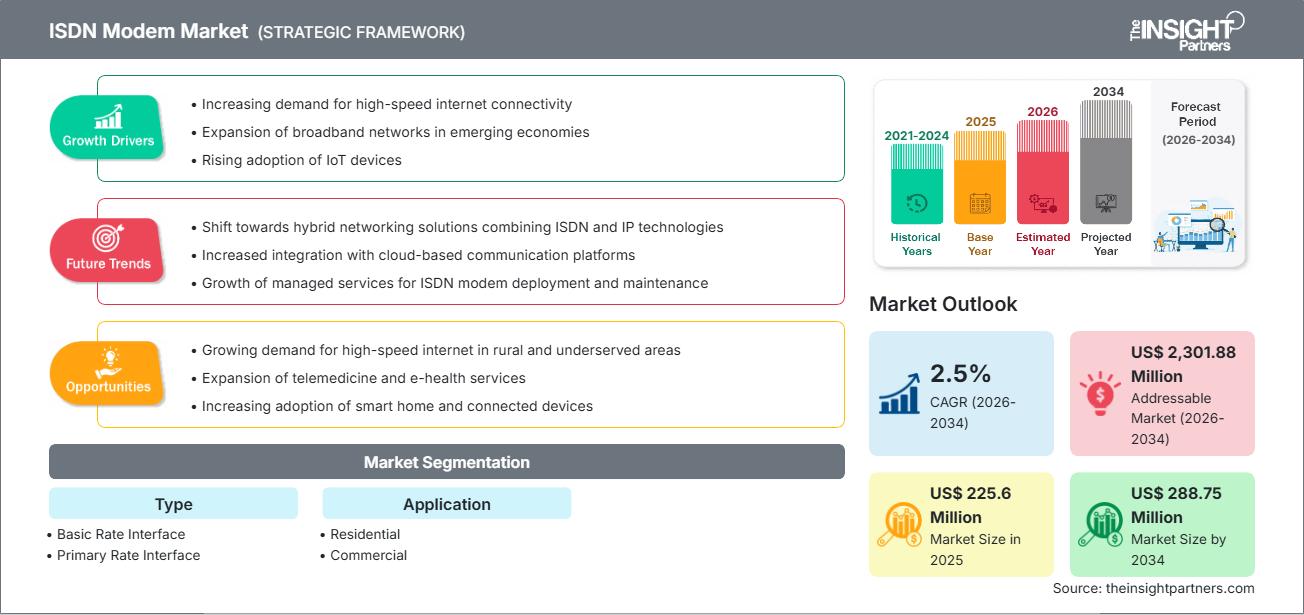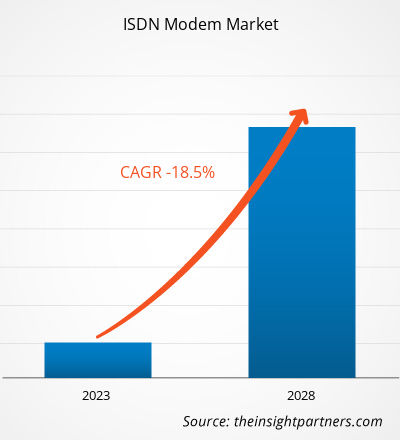Der Markt für ISDN-Modems wird voraussichtlich von 225,6 Millionen US-Dollar im Jahr 2025 auf 288,75 Millionen US-Dollar im Jahr 2034 ansteigen, was einer durchschnittlichen jährlichen Wachstumsrate (CAGR) von 2,5 % im Prognosezeitraum entspricht.
ISDN-Modem-Marktanalyse
Die Prognose für den ISDN-Modemmarkt deutet auf einen Rückgang hin, der vor allem durch den raschen Übergang von herkömmlichen ISDN-Infrastrukturen zu IP-basierten Kommunikationstechnologien und Breitband bedingt ist. Dennoch besteht in bestimmten Regionen und Anwendungsfällen weiterhin eine Nischennachfrage nach ISDN-Modems, insbesondere als Backup für ältere Telefoninfrastrukturen, in unterentwickelten Märkten oder bei Unternehmen, die aus Gründen der Zuverlässigkeit und Sicherheit weiterhin auf ISDN-basierte Sprach- oder Datenleitungen angewiesen sind.
Der rückläufige Bedarf an Modernisierung und Erneuerung der ISDN-Infrastruktur sowie der Kostendruck für die Instandhaltung älterer Netze drücken den Markt deutlich nach unten. Dennoch entwickeln einige Anbieter weiterhin innovative ISDN-Modems mit Hybridkompatibilität, modularem Design und effizientem Energieverbrauch, um die schrumpfende, aber weiterhin bestehende Kundschaft zu bedienen.
ISDN-Modem-Marktübersicht
ISDN-Modems (Integrated Services Digital Network) sind Kommunikationsgeräte, die die digitale Übertragung von Sprache, Video und Daten über herkömmliche Kupferleitungen ermöglichen. Sie unterstützen B-Kanäle für Daten/Sprache und einen D-Kanal für die Signalisierung und bieten typischerweise einen Durchsatz von bis zu 128 kbit/s für BRI (Basic Rate Interface). ISDN-Modems waren in der Vergangenheit wichtig für Mehrleitungs-Sprach- und Datenanwendungen, sichere Telefonie und strukturierte Unternehmenskommunikation. Auch mit dem Übergang von Netzbetreibern und Unternehmen zu VoIP und Breitband bleiben ISDN-Modems vor allem in Altsystemen, Backup-Leitungen und bestimmten regulierten Umgebungen relevant.
Passen Sie diesen Bericht Ihren Anforderungen an.
Sie erhalten eine kostenlose Anpassung aller Berichte – einschließlich Teilen dieses Berichts, Länderanalysen und Excel-Datenpaketen – sowie attraktive Angebote und Rabatte für Start-ups und Universitäten.
ISDN-Modemmarkt: Strategische Einblicke

-
Ermitteln Sie die wichtigsten Markttrends dieses Berichts.Diese KOSTENLOSE Probe beinhaltet eine Datenanalyse, die von Markttrends bis hin zu Schätzungen und Prognosen reicht.
Markttreiber und Chancen für ISDN-Modems
Markttreiber:
- Abhängigkeit von veralteter Infrastruktur: Einige Organisationen und Telekommunikationsnetze setzen weiterhin auf ISDN, um Zuverlässigkeit und Mehrleitungsverbindungen mit geringer Latenz zu gewährleisten.
- Bedarf an Backup-Konnektivität: In Regionen oder Unternehmen, in denen Breitband weniger zuverlässig oder nicht verfügbar ist, dienen ISDN-Leitungen als Ausweich- oder Redundanzoption.
- Regulierte und sichere Kommunikation: Die leitungsbasierte Kommunikation von ISDN kann in einigen regulierten Sektoren als sicherer oder deterministischer wahrgenommen werden, was einen Nischenanwendungsfall begründet.
Marktchancen:
- Entwicklung von Hybridsystemen: Für ISDN-Modemhersteller könnten sich Möglichkeiten ergeben, Hybridmodems zu entwickeln, die sowohl mit ISDN- als auch mit IP-Netzwerken kompatibel sind und damit Organisationen bedienen, die eine langsame Migration durchführen.
- Schwellenländer & Ländliche Nutzung: In Entwicklungsländern oder ländlichen Gebieten, in denen die Breitbandinfrastruktur erst im Aufbau ist, können ISDN-Anschlüsse weiterhin bestehen, was Modemanbietern die Möglichkeit bietet, diese älteren Installationen zu bedienen.
- Anwendungsfälle im Bereich IoT und Industrie: Einige IoT- oder Industrieanwendungen, die stabile, leitungsvermittelte Verbindungen mit niedriger Datenrate erfordern, könnten ISDN in speziellen Implementierungen nutzen.
Marktbericht ISDN-Modems: Segmentierungsanalyse
In typischen Marktforschungsberichten (ähnlich der Struktur von The Insight Partners) kann der ISDN-Modemmarkt wie folgt segmentiert werden:
Nach Typ:
- Basic Rate Interface (BRI)
- Primäre Datenschnittstelle (PRI)
Auf Antrag:
- Wohnnutzung
- Gewerbliche / unternehmerische Nutzung
Nach Geographie:
- Nordamerika
- Europa
- Asien-Pazifik
- Naher Osten und Afrika
- Süd- und Mittelamerika
Regionale Einblicke in den ISDN-Modemmarkt
Die regionalen Trends und Einflussfaktoren auf den ISDN-Modemmarkt im gesamten Prognosezeitraum wurden von den Analysten von The Insight Partners ausführlich erläutert. Dieser Abschnitt behandelt außerdem die Marktsegmente und die geografische Verteilung des ISDN-Modemmarktes in Nordamerika, Europa, Asien-Pazifik, dem Nahen Osten und Afrika sowie Süd- und Mittelamerika.
Umfang des ISDN-Modem-Marktberichts
| Berichtattribute | Details |
|---|---|
| Marktgröße im Jahr 2025 | 225,6 Millionen US-Dollar |
| Marktgröße bis 2034 | 288,75 Millionen US-Dollar |
| Globale durchschnittliche jährliche Wachstumsrate (2026 - 2034) | 2,5 % |
| Historische Daten | 2021-2024 |
| Prognosezeitraum | 2026–2034 |
| Abgedeckte Segmente |
Nach Typ
|
| Abgedeckte Regionen und Länder |
Nordamerika
|
| Marktführer und wichtige Unternehmensprofile |
|
Marktdichte von ISDN-Modems: Auswirkungen auf die Geschäftsdynamik verstehen
Der Markt für ISDN-Modems wächst rasant, angetrieben durch die steigende Nachfrage der Endnutzer. Gründe hierfür sind unter anderem sich wandelnde Verbraucherpräferenzen, technologische Fortschritte und ein wachsendes Bewusstsein für die Vorteile des Produkts. Mit steigender Nachfrage erweitern Unternehmen ihr Angebot, entwickeln innovative Lösungen, um den Kundenbedürfnissen gerecht zu werden, und nutzen neue Trends, was das Marktwachstum zusätzlich beflügelt.

- Verschaffen Sie sich einen Überblick über die wichtigsten Akteure auf dem ISDN-Modemmarkt.
Marktanteilsanalyse für ISDN-Modems nach Regionen
Hier eine hypothetische oder abgeleitete regionale Aufschlüsselung und die wichtigsten Trends:
-
Nordamerika
- Vermutlich hält er aufgrund der historischen ISDN-Infrastruktur und der Anforderungen an die Geschäftskontinuität einen bedeutenden Anteil.
- Einige Unternehmen und Callcenter nutzen ISDN für veraltete Sprach- und Datenleitungen.
-
Europa
- Mäßiger Anteil, wobei regulatorische und bestehende Infrastrukturen die Nachfrage in bestimmten Sektoren weiterhin aufrechterhalten.
- Möglicher Schwerpunkt auf hybriden ISDN-IP-Implementierungen.
-
Asien-Pazifik
- Ein kleinerer, aber dennoch relevanter Anteil, insbesondere in Regionen, in denen die IP-Infrastruktur noch weit verbreitet ist oder veraltete Telekommunikationsleitungen weiterhin bestehen.
- Chancen in ländlichen oder sich entwickelnden Märkten.
-
Naher Osten und Afrika, Süd- und Mittelamerika
- Neue Nische für ISDN-Modems in älteren Telekommunikationssystemen.
- Insgesamt geringeres Volumen, aber strategische Bedeutung für Anbieter von Backup-Leitungen oder den Einsatz in kleinen Unternehmen.
Marktdichte von ISDN-Modems: Auswirkungen auf die Geschäftsdynamik verstehen
Der Markt für ISDN-Modems ist zunehmend ein Nischenmarkt und von veralteten Produkten geprägt, aber es gibt immer noch Wettbewerb:
-
Strategische Differenzierungsmerkmale:
- Hybrid ISDN/IP-Kompatibilität
- Modulare, energieeffiziente Designs
- Wartungsarm, sichere Legacy-Konnektivität
-
Wettbewerbsauswirkungen:
- Sinkende Marktvolumina begünstigen Konsolidierung oder Spezialisierung.
- Anbieter können in Märkten, in denen noch herkömmliche ISDN-Leitungen existieren, Partnerschaften mit Telekommunikationsbetreibern eingehen.
- Einige konzentrieren sich eher auf fortschrittliche ISDN-Modems für spezielle oder industrielle Anwendungen als auf die Massenkommunikation.
Chancen / Strategische Schritte für Spieler:
- Entwicklung kosteneffizienter BRI/PRI-Modems mit Backup-Leitungs-Potenzial.
- Förderung modularer Hybridgeräte für Unternehmen, die auf VoIP umsteigen, aber ISDN-Leitungen aus Redundanzgründen beibehalten.
- Erkunden Sie aufstrebende Märkte, in denen die ISDN-Infrastruktur noch funktionsfähig, aber untergenutzt ist.
Die wichtigsten Akteure auf dem Markt:
- Ekinops
- TERRATEL
- Patton LLC
- A TLC Srl
- Epygi Technologies LLC
- Polycom
- Xiamen Yeastar Information Technology Co., Ltd.
- HypermediaS
- Aristel Networks
Weitere Unternehmen, die im Rahmen der Untersuchung analysiert wurden:
- Adtran, Inc.
- DrayTek Corp.
- US-Robotik
- AVM GmbH
- Fritz!Box-Serie (von AVM)
- Black Box Network Services, Inc.
- MultiTech Systems, Inc.
- Westermo Network Technologies AB
- 2NTelekomünikasyone as
- Belkin International, Inc.
Neuigkeiten und aktuelle Entwicklungen auf dem ISDN-Modemmarkt
- Einige Modemhersteller setzen weiterhin auf Innovationen: zum Beispiel auf Hybridmodems, die ISDN- und IP-Funktionalitäten kombinieren, oder auf energieeffiziente ISDN-Modelle, um die Nische der älteren Modems zu bedienen.
- In Regionen mit unterentwickeltem Breitbandausbau oder in Unternehmen, die auf ISDN für redundante Sprach-/Datenkanäle angewiesen sind, besteht eine begrenzte, aber stetige Nachfrage.
ISDN-Modem-Marktbericht: Abdeckung und Ergebnisse
Der hypothetische Bericht „ISDN-Modem-Marktgröße und Prognose (2021–2034)“ von The Insight Partners würde Folgendes beinhalten:
- Prognosen zur Marktgröße auf globaler, regionaler und Länderebene für alle wichtigen Segmente.
- Tiefgehende Analyse von Markttrends und -dynamiken (Treiber, Hemmnisse und Chancen).
- PEST- und SWOT-Analysen helfen, makropolitische, wirtschaftliche, soziale und sektorale Kräfte zu verstehen.
- Wettbewerbsumfeld: Unternehmensprofile, Marktkonzentration, Heatmap-Analyse.
- Aktuelle Entwicklungen und strategische Schritte der wichtigsten Akteure.
- Historische Analyse (2 Jahre), Basisjahr, Prognose (7 Jahre) mit CAGR
- PEST- und SWOT-Analyse
- Marktgröße Wert/Volumen – Global, Regional, Land
- Branchen- und Wettbewerbslandschaft
- Excel-Datensatz
Aktuelle Berichte
Erfahrungsberichte
Grund zum Kauf
- Fundierte Entscheidungsfindung
- Marktdynamik verstehen
- Wettbewerbsanalyse
- Kundeneinblicke
- Marktprognosen
- Risikominimierung
- Strategische Planung
- Investitionsbegründung
- Identifizierung neuer Märkte
- Verbesserung von Marketingstrategien
- Steigerung der Betriebseffizienz
- Anpassung an regulatorische Trends






















 Kostenlose Probe anfordern für - ISDN-Modemmarkt
Kostenlose Probe anfordern für - ISDN-Modemmarkt